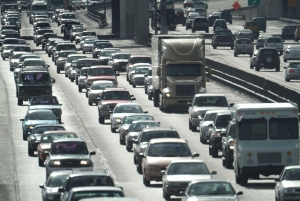

Photo courtesy of Texas A&M Transportation Institute.
There are few things more aggravating than being stuck in traffic on a regular basis. The frustration that results is detrimental to productivity and the stress it causes does bad things to a driver’s overall health and well- being.
The Texas A&M Transportation Institute last month issued its 2015 Urban Mobility Scorecard and, to no one’s surprise, major cities in Texas ranked poorly. Houston, Dallas and Austin all rank in the top 12 cities in the country in terms of hours lost to traffic delays. Cumulatively, U.S. drivers experienced 6.9 billion hours of extra travel time lost to congestion in 2014. That translates to 3.1 billion gallons of fuel wasted and a total cost of $160 billion when time lost and fuel costs are included. The average Houston driver spent an extra 61 hours in a vehicle. That number was 53 hours for Dallas motorists and 52 hours for Austinites.
What can be done, other than build more roads and hope Congress finally passes a permanent transportation bill?
We might also benefit from looking at successes other countries are having in reducing congestion. Singapore and a number of other large cities use data analytics and real-time information to predict traffic flow patterns. The information is used to adjust and manage the flow of traffic. Public transportation ridership is also much higher in other countries. Rail is extremely popular and efficient as well.
A&M’s Transportation Institute offers an array of strategies for dealing with traffic congestion. Some of the solutions offered are ones we’ve heard many times, such as carpooling, flexible office work schedules, coordinated traffic signals, etc. The report, however, also urges municipal engineers to use real-time information to enable traffic signals to “automatically retime and coordinate themselves to the most efficient plan, reducing delay up to 40 percent and increasing throughput up to 60 percent.”
Another suggestion comes in the form of reversible traffic lanes that increase traffic flow in one direction at peak times by changing the direction of certain lanes depending on patterns of use. In Texas, the city of Arlington has had success implementing this system in the area around its two major sports stadiums.
“Ramp flow control” can be very effective if traffic signals are placed on highway entry ramps. This avoids bottlenecks as slower-moving cars enter from feeder roads and merge with highway traffic. While this delays slightly the entrance of cars onto a freeway, it also keeps incoming traffic from crowding out swiftly moving vehicles. Atlanta and Portland report success with ramp flow control because both have reported increases in travel speed, decreases in crashes and reductions in emissions by doing this.
Interestingly enough, many of the drivers who complain the loudest about congestion are not quick to embrace change. Public buy-in is not easily accomplished as many public officials know all too well. Drivers must be convinced of the benefits before they endorse change.
Innovation is a critical component in solving the country’s traffic problems and there is no doubt that changes must occur. Best to remember that change is accepted best with aggressive and continual communication along with a little PR.
As transportation issues in major cities continue to arise, find out how your business can help provide local transportation infrastructure to all cities.
